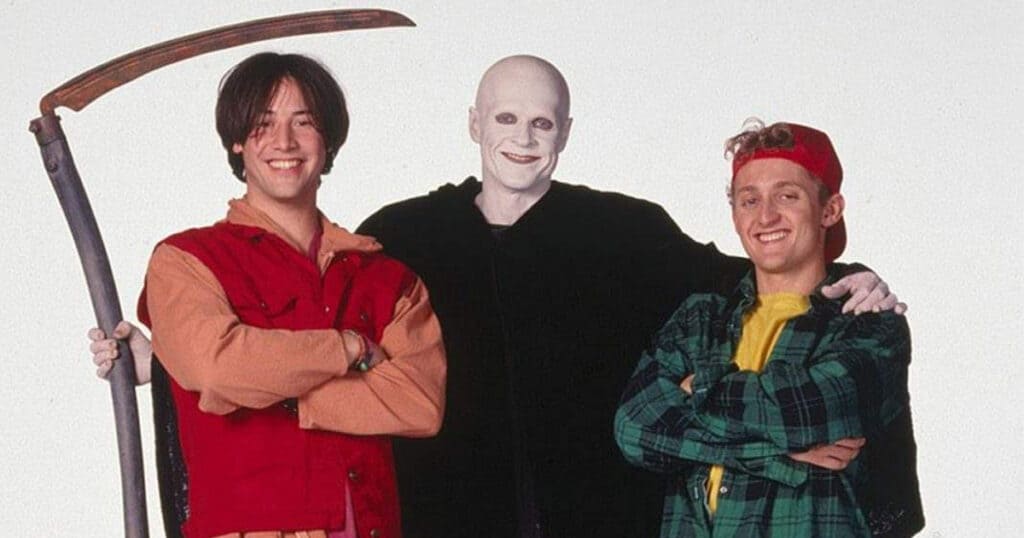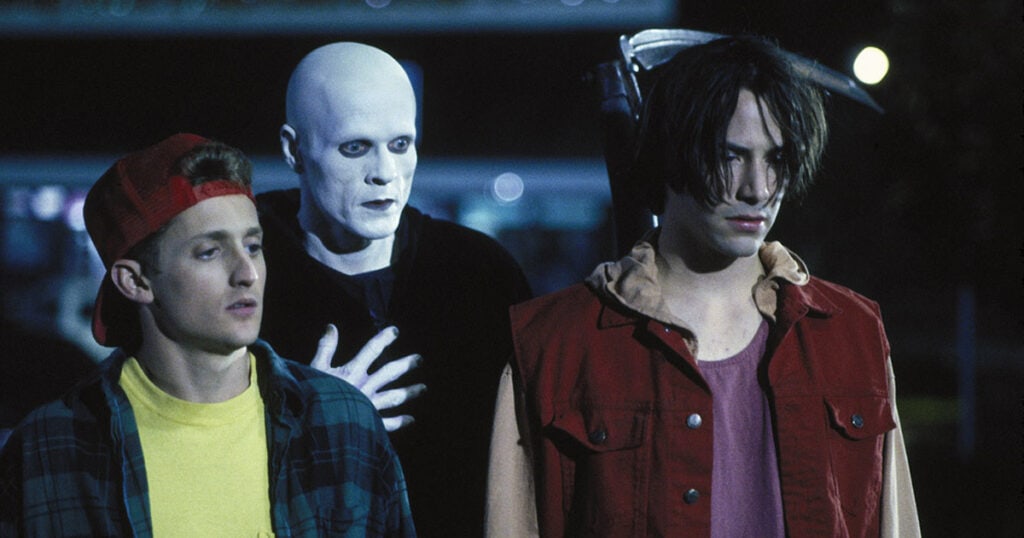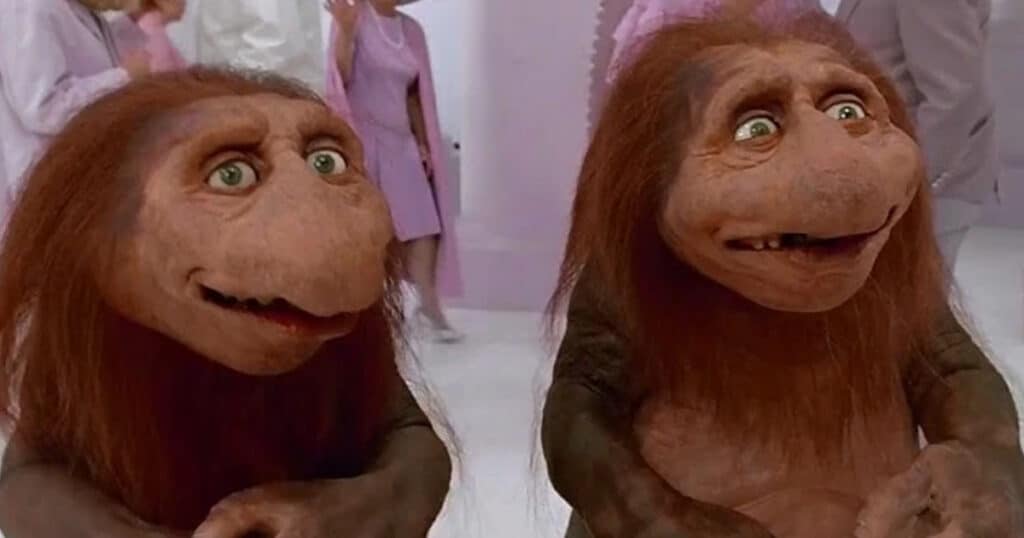In 1989 Orion Pictures, along with Nelson Entertainment released Bill & Ted’s Excellent Adventure. The film was widely loved, and still is, to this day by both critics and fans alike. Because the film was so popular, spawned tons of merchandise and even had two spinoff shows…a sequel was inevitable.
This isn’t just any sequel, it’s Bill & Ted’s Bogus Journey. At the time regarded as a love it or hate it film and was considered a box office failure. So let’s go to hell, visit heaven, build some evil and good robots and face off in the Battle of Bands as we check out Bill & Ted’s bonkers follow up on this episode of Revisited.
As stated earlier, Bill & Ted’s Excellent Adventure was released in February 1989 and became a huge success. People couldn’t get enough of the two brain dead yet incredibly likable pair of Bill and Ted. The film grossed $40 million domestically on a budget of $10 million. Orion Pictures demanded a sequel and wanted something that would follow up their hit.
Chris Matheson and Ed Solomon would get to work writing the sequel. Orion wanted Bill and Ted to pass an English test and visit classic works of literature, such as Romeo and Juliet, Crime and Punishment and Tom Sawyer. Chris and Ed gave a hard pass to the idea and instead would come up with Bill & Ted Go To Hell. The title was changed to Bill & Ted’s Bogus Journey because of American objections to the word hell. Once the script was sent in, the studio executives immediately said no to killing off Bill and Ted. The writers and actors stood firm on the premise, realizing that it was too good an idea not to do.
Keanu Reeves and Alex Winter would come back and reprise their roles and play their Evil Robot selves, but some new characters would join the film as well. One would stand out above the rest, and that is Death, also known as the Grim Reaper, played by William Sadler aka Colonel William Stuart from Die Hard 2. When the boys arrive in Hell, he challenges them to a series of games to regain their lives similar to the film The Seventh Seal, in which a knight plays Death in a game of chess for his life. Once defeated, Death shows his comedic side and becomes a part of the gang as the film progresses. His performance is the best part of the movie. He brings a blend of humor and eccentricity to the character as well as sports a huge ego and is overly dramatic, but a scene stealer nonetheless.
Also brought on was the character of Chuck De Nomolos, played by actor Joss Ackland. He would be named after the screenwriter Ed Solomon, which is his name backwards. De Nomolos would serve as the main antagonist to the film. He adds a serious and sinister tone to the film and is driven by a desire to create a dystopian future where he holds all power. Unfortunately, he feels half baked and doesn’t come off as menacing as you would think. Joss Ackland said in an interview that he only did the movie because of a bet between him and a family member and considers it an embarrassment in his career. Several characters would return such as Rufus, The Princesses aka the babes, Bill and Ted’s Dads as well as Missy.
So what’s it all about? In the year 2691, Wyld Stallyns created a utopian futuristic society. Chuck De Nomolos crashes a lesson that Rufus is teaching to send evil robot versions of Bill and Ted to the past and eliminate the real Bill and Ted. The robots travel back in time to 3 years after Bill and Ted have graduated high school and have entered the contest for Battle of the Bands. They want to win the cash prize of $25,000 as well as land a record deal…but they still suck. We catch up with the boys and see how much their lives have and haven’t changed. For one, they are still with the princesses from the first film and are getting ready to propose as well as Missy moving on from Bill’s Dad to Ted’s Dad. The evil robots come to their apartment and lure them away to Vasquez Rocks and kill them by throwing our loveable idiots off a cliff. The robots go on to ruin their lives including trashing their apartment and breaking up with the princesses.

The real Bill and Ted are met in the afterlife by Death who tells them they can challenge him in a game. They end up giving Death a Melvin and run back home to try and contact the police so Bill possesses his Dad, in what amounts to one of the funniest scenes in the movie. They then go to Ted’s house and see Missy doing a seance. She believes their spirits to be evil and banishes them to Hell. In Hell, they end up being tormented by Satan and facing their fears including visiting Bill’s creepy grandma, a terrifying Easter Bunny that would give any child nightmares and Colonel Oats at his Military Academy. Bill and Ted challenge Death to a series of games to earn their lives back, eventually winning and escaping the afterlife. They go to Heaven and God directs them to an alien duo known as Station. Station goes with them back to Earth and helps build good robot versions of themselves to battle against the evil robots.
Bill and Ted confront the evil robots by destroying them with the good robots and save the princesses. De Nomolos crashes in at the nick of time and overrides all broadcasts across the world to show him killing Bill and Ted on stage. Our boys deduce the fact that they can go back in time and outsmart De Nomolos.
Bill and Ted then take the time booth to go into the future and come back after sixteen months of guitar training, sporting ZZ-Top outfits and have kids of their own. In the end, the Battle of the Bands performance is a success, and Bill and Ted’s music unites the world, leading to the harmonious future that was originally meant to happen. The film closes with Bill and Ted reflecting on their journey and embracing their role as the legendary rockers who will change the world. Sounds like a heavy film that has a runtime of only 93 minutes!
Production began in July 1990 and wrapped after 12 weeks. Filming would take place in California instead of Arizona. Some great landmarks were used as filming locations such as The Japanese Garden of the Tillman Water Reclamation Plant in Van Nuys, California and The San Dimas Civic Auditorium which is no longer open to the public but is available for filming and private event.s The most famous landmark in the film is at the Vasquez Rocks Natural Area Park in Southern California. Movies like The Flintstones, Blazing Saddles as well as Jay and Silent Bob Strike Back have all filmed in this location including the original Star Trek TV series. Filming at this location involved the Evil Bill and Ted throwing our heroes off the cliff to their deaths as well as when they meet Death.

Stephen Herek wouldn’t return to direct. He was replaced with Peter Hewitt at the helm. Peter Hewitt would bring on Oliver Wood as Director of Photography, who previously shot Die Hard 2 and would go on to DP for Face/Off, Talladega Nights, The Bourne Trilogy and Morbius.
Solomon and Matheson wrote a film that had previously wrapped shooting entitled Mom and Dad Save the World, a film that if you grew up in the 90’s would always see playing on HBO. The studio delayed the set’s demolition so it could be used to film in Bogus Journey. You’ll notice the remnants of the set as the ceiling of the future classroom in the beginning of the movie.
David L. Snyder, of Pee Wee’s Big Adventure fame, was brought on as Production Designer. He would help bring a sense of forced perspective to the film along with the crew. David even came up with a cool way to make Bill and Ted look dead for their afterlife. Instead of adding a filter or effect in a computer, they are painted with grayscale which was done with make-up and costume colors. Everything about Bogus Journey screams surreal and the set design of the film would be based on circles, domes and spheres, which is prominent throughout the Heaven and Hell scenes. It looks just fantastic and holds up well today. You really feel a sense of claustrophobia during the Hell chase scene.
Kevin Yagher was responsible for creature effects. He helped build the Easter Bunny, Station, as well as the good robot versions of Bill and Ted. Kevin had previous experience designing and creating Chucky for the original Child’s Play. He was able to bring his skills in giving the Easter Bunny the same type of look and movement…no wonder I was terrorized by both of those puppets as a kid. In regards to Station’s look, the original design was something straight out of The Dark Crystal. Kevin would give Station a big butt in which Ed and Chris signed off on loving the look. Producer Scott Kroopf thought Station was too controversial and that audiences wouldn’t find them funny or appealing…glad to see he was proven wrong. Because the production didn’t have a big enough budget to create actual robots, the crew hired breakdancers to don the robot costumes and mimic robotic movements. The result is incredible and one of the highlights of the film. Kevin would also dress up Alex Winter to play his grandma in the nightmarish scene.
There are TONS of celebrity cameos in this film. First off, at the Battle of the Bands, we see Primus appear as themselves performing their song “Tommy The Cat”. Jim Martin, who was the lead guitarist of Faith No More at the time, appears as himself. Rufus introduces him as the head of the Faith No More Spiritual and Theological Center. Anyone who was born in the late 90’s to early 2000’s would probably have this reference go over their head. Pam Grier makes an appearance as Ms. Wardrobe, who is in charge of Battle of the Bands, but is really Rufus in disguise and Taj Mahal, a famous blues musician, plays the gatekeeper of heaven. Even the director, Pete Hewitt shows up in the hardware store as well as our good ole boys Chris Matheson and Ed Solomon stopping by for Missy’s seance. Their camo isn’t as memorable this time around as their Ziggy Piggy appearance, but it’s still great to see them pop in.

Notably there are some scenes that were filmed either fully or partially that would never make it to the finalized film and have been hard to track down online. Two scenes in particular stand out. The first one consists of Evil Bill and Ted unzipping themselves to reveal that they are each other in different bodies. There are pictures showcasing the suits that they zip out of which look pretty realistic. The second scene is a car chase scene. You may be thinking to yourself “When and how would this happen? This movie is already stuffed to the brim?” It takes place after the boys have acquired their van and are heading to the concert. We see Colonel Oats, the creepy grandmother and an even scarier full grown Easter Bunny chasing after our heroes to prevent them from making it to the Battle of the Bands. A portion of this scene was filmed, with pictures surfacing of the Easter Bunny ripping the top of the van. In the Marvel comic that was released to coincide with the film, this scene along with several other deleted scenes were included thanks to Evan Dorkin. He would adapt the screenplay and pencil the art. Speaking of the comic book, because of its popularity, Marvel commissioned a spin-off series entitled Bill & Ted’s Excellent Comic Book which ran for 12 issues and would feature original stories.
Months before the release of Bogus Journey, Orion Pictures was on the verge of bankruptcy. They were in the process of selling off the rights to several films in an attempt to remain stable. After careful consideration, they kept it because Orion had faith in Bill and Ted’s second on screen presence.
Bill & Ted’s Bogus Journey would be released theatrically on July 19,1991. It opened in second place grossing $10 million on its opening weekend. behind Terminator 2: Judgement Day and funny enough, this film mocks the plot of the first Terminator. Critics and audiences weren’t too favorable of it at the time. With it currently sitting at a 55% on Rotten Tomatoes, the critics consensus reads “Bill & Ted’s Bogus Journey has the same stars – and cheerfully wacky sense of humor – as its predecessor, but they prove a far less effective combination the second time around.” Some critics would say that it was funnier than the first while others called it sloppy and overcomplicated. The film would go on to gross $38 million domestically which was less than Excellent Adventure made after its initial box office run.
Bogus would be released on VHS in January 1992. In December of 2001, Bogus and Excellent would be released alongside each other on DVD. Not until November 2018 would us fans get a proper release. Shout Factory released both Excellent and Bogus in a beautiful package entitled Bill & Ted’s Most Excellent Collection on Blu-ray. The picture quality for both looks impressive and its packed with tons of special features including documentaries on the making of both Excellent Adventure and Bogus Journey, Vintage EPKs, Documentaries on the historical figures they encounter, creation of the characters with Chris and Ed as well as so much more. As a huge fan of both films, this sits proudly in my collection and is something I’ll regularly put on to watch.
There would be talks of a third film to complete the trilogy and eventually in 2020, us fans got to experience it. Granted, it came out during the Covid Pandemic and felt more like a stay at home movie than a theatrical experience…but that’s a story for another time.
Over the years, Bill & Ted’s Bogus Journey would receive a cult status from viewers. Some who didn’t come around to it the first time would give it another shot and end up enjoying it the more they saw it. I am one of those few who consider Bogus to be better than the first. Why? Well, for one it’s something different and original…in its own way. Hear me out, I’m not knocking Excellent in any way, I just prefer the forced perspective look and feel of the film as well as the lengths of absolute absurdity that Chris and Ed created. The afterlife sequences are truly a highlight and are scenes that are still cemented in my brain over 30 years later. The introduction of Death was fresh and brought a whole new dynamic to the story that we didn’t know we needed. This film took a HUGE risk and even though it didn’t fully pay off theatrically, it would with fans who got to experience it on home video.
Despite its departure from the first film’s formula, Bogus Journey maintains the core themes of friendship that made Bill and Ted so loveable from the first film. It deserves praise for its willingness to take such risks and offer a completely bonkers adventure and makes for some imaginative storytelling.
In conclusion Bill & Ted’s Bogus Journey is a sequel that successfully builds on its predecessor while venturing into uncharted horror comedy territory. With its inventive afterlife scenarios, hilarious performances and underlying themes of friendship and unity, the film stands as a testament to the power of creative storytelling.

